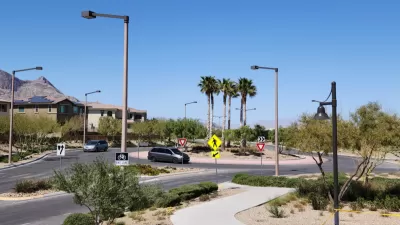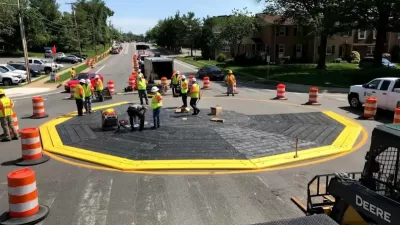"Shared streets" guru Ben Hamilton-Baillie has shown in the U.K. that there are a lot of better ways to manage traffic than stoplights. CNU asked Ben, as he prepares to come to the United States, if shared streets could work here.

"I am convinced that the principle of shared space and low-speed, civilised streets could be beneficially applied in North America," said Hamilton-Baillie in the interview. "Although the urban form, scale and context is often very different – and often particularly challenging! – human psychology is the same everywhere. And it is working with the grain of human behaviour and interaction which lies at the heart of shared space."
The Town of Ponyton, UK is one of Hamilton-Baillie's success stories. A video about the town's transformation can be seen here. The video shows the importance of paving materials and other subtle cues that slow traffic and make it possible to combine people, bikes and traffic safely.
"Just as in architecture, paving materials help convey values, priorities and purpose," says Hamilton-Baillie. "Recent street design has often been limited to a very limited palette of asphalt or concrete. Whilst these are excellent materials, we often use a much wider range of paving materials such as blocks, setts or cobbles, materials that can respond to the buildings or surroundings, and which can influence behaviour through our visual, auditory and tactile senses. Blocks often suggest lower speeds, and can be useful to contrast with more linear elements of streets. But we also use surface applications, paints, bonded gravel – anything that helps tell a rich story."
Ben Hamilton-Baillie will be sharing his experience with shared streets on June 6th at CNU 22 in Buffalo, New York.
FULL STORY: Talking with Ben Hamilton-Baillie About Shared Streets

Study: Maui’s Plan to Convert Vacation Rentals to Long-Term Housing Could Cause Nearly $1 Billion Economic Loss
The plan would reduce visitor accommodation by 25,% resulting in 1,900 jobs lost.

North Texas Transit Leaders Tout Benefits of TOD for Growing Region
At a summit focused on transit-oriented development, policymakers discussed how North Texas’ expanded light rail system can serve as a tool for economic growth.

Why Should We Subsidize Public Transportation?
Many public transit agencies face financial stress due to rising costs, declining fare revenue, and declining subsidies. Transit advocates must provide a strong business case for increasing public transit funding.

How to Make US Trains Faster
Changes to boarding platforms and a switch to electric trains could improve U.S. passenger rail service without the added cost of high-speed rail.

Columbia’s Revitalized ‘Loop’ Is a Hub for Local Entrepreneurs
A focus on small businesses is helping a commercial corridor in Columbia, Missouri thrive.

Invasive Insect Threatens Minnesota’s Ash Forests
The Emerald Ash Borer is a rapidly spreading invasive pest threatening Minnesota’s ash trees, and homeowners are encouraged to plant diverse replacement species, avoid moving ash firewood, and monitor for signs of infestation.
Urban Design for Planners 1: Software Tools
This six-course series explores essential urban design concepts using open source software and equips planners with the tools they need to participate fully in the urban design process.
Planning for Universal Design
Learn the tools for implementing Universal Design in planning regulations.
City of Santa Clarita
Ascent Environmental
Institute for Housing and Urban Development Studies (IHS)
City of Grandview
Harvard GSD Executive Education
Toledo-Lucas County Plan Commissions
Salt Lake City
NYU Wagner Graduate School of Public Service





























